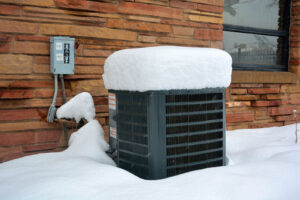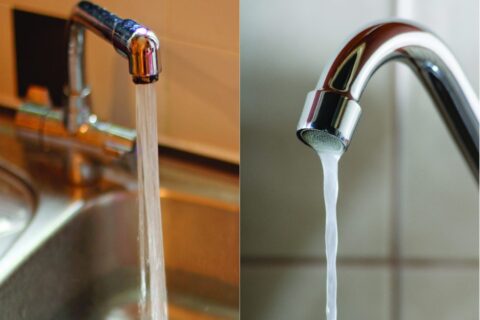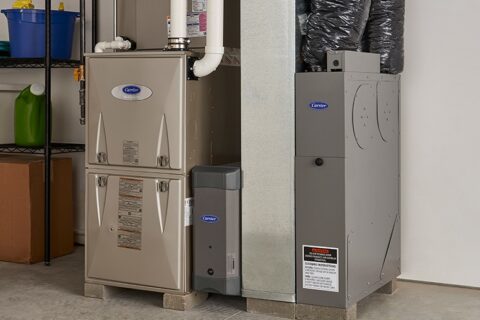How to Prepare Your HVAC System for Colorado’s Snowstorms
Key Takeaways
-
Regular HVAC maintenance will help prevent costly repairs when the blizzards hit Colorado, and keep you comfortable all winter long.
-
Clean and replace air filters regularly to ensure proper airflow, better air quality, and lower energy bills.
-
Clear air vents, ducts, and your outdoor unit to increase efficiency and avoid damage from debris or snow accumulation.
-
Install a programmable thermostat and seal air leaks to improve heating efficiency and reduce utility costs.
-
Insulate any exposed pipes and insulate or cover any outdoor units to prevent the expensive repairs that can result from freezing temperatures.
-
Consider keeping emergency supplies on hand this winter, including backup power sources, additional filters, and emergency HVAC professional contacts.
Preparing your HVAC system for Colorado’s snowstorms means a warm, safe, and more reliable home when the winter months hit. When extreme cold and heavy snowfall are taxing heating systems, routine maintenance and preventative checkups can mean the difference between warmth and emergency repair calls.
Taking simple steps such as replacing filters, inspecting vents, and scheduling a professional tune-up can make your system more efficient, ward off breakdowns, and save you money. Keeping your system running at peak performance is good for staying comfortable inside without breaking the bank on energy bills.
With Colorado’s unpredictable weather, it’s important for homeowners to proactively prevent these issues from becoming an emergency. Being proactive with a properly maintained HVAC system will save you time, money, and stress once those snowstorms hit!
Some simple prep work now will go a long way when those months come.
Why Prepare Your HVAC System
Preparing your HVAC system now will save you from these disruptions and ensure your home stays warm, efficient and cost-effective all winter long. When maintenance is neglected, it can result in sudden failures, increased costs, and a lack of comfort during extreme temperatures.
Here’s why taking these steps matters:
Prevent System Failures
That strain due to extreme cold is another reason regular HVAC system maintenance is important. Begin with a general visual inspection for signs of wear and tear, such as cracks or other signs of obvious damage.
A quick test-run of your heating system will ensure that it is prepared to face the cold. Keep up with air filter changes. Air filters should be replaced monthly, especially in peak-use months, to maintain clean airflow and avoid overworking the system.
Additionally, review your thermostat settings to make sure they’re properly programmed to account for demand in the winter months. Undetected issues, such as damaged parts, can intensify with use, resulting in expensive long-term damage.
Ensure Indoor Comfort
A comfortable home during these snowstorms hinges on a working and well-maintained HVAC system. Cleaning air vents and ducts helps improve airflow, while regularly replacing filters cuts down on dust accumulation.
Outdoor units require debris removal to keep them from overheating. Proper lubrication of all moving parts reduces wear, increasing the overall efficiency of the unit. Simple measures such as these go a long way toward ensuring steady warmth indoors.
Save on Energy Costs
Tighter HVAC operation translates to more energy-efficient operation and energy savings for your bottom line. In addition, leaky ducts can lose the heat you’re paying for, making your system work much harder.
Actions like sealing leaks and stocking spare filters can save you from costly inefficiencies later. A standby generator installation will prevent your HVAC from stopping during these outages, frequent in Colorado winters.
Smart technology programmable thermostats, now usually equipped with smart technology, can automatically change settings for you based on your habits, saving energy and making your life easier.
Avoid Expensive Repairs
By taking preventive steps now, you can help avoid expensive repairs down the line. Insulate any exposed pipes to prevent freezing during cold snaps.
If you have outdoor units, cover them up to protect them from ice and snow. Sealing air leaks in ducts improves heating efficiency, while programmable thermostats optimize heating schedules.
As they say, prevention is always better—and much more cost effective—than the cure.
Inspect Your HVAC System
Check for Visible Damage
Snowstorms in Colorado can wreak havoc on outdoor HVAC units. So inspecting them on a regular basis for any visible damage is key. Start by looking for signs of ice build-up on the outdoor unit. Ice buildup can weigh down and break up the fan blades or coils. This could result in costly repairs.
Removing snow from the unit is just as essential. By ensuring proper airflow through a clear unit, your system can run as efficiently as possible, even in subzero temps. Get in the practice of checking for dents, cracks or other wear after a storm.
Keep in mind that operating an HVAC system with undetected damage can lead to lasting damage. Regular maintenance helps your equipment last longer and prevents unexpected energy bill spikes. Plus, a properly maintained unit is an energy-efficient unit, so you’ll save on utility bills all winter long.
Keeping your air filters and ducts clean can help improve your indoor air quality. This is particularly true in colder months when we’re sealing our windows shut.
Test System Performance
Inspecting and testing your system’s performance is an important third step. Watch for variations in indoor temperatures. If some rooms are always warmer or cooler than others, it could be an indication that something is wrong.
Specifically look out for unusual noises or odors, which can be a sign of internal component failure. Setting up annual maintenance before the snow arrives makes sure your system is operating efficiently when you need it the most!
Inspect Air Filters
Fresh air filters help keep your system running efficiently and improve indoor air quality. If your air filter is clogged with dirt, your HVAC system must work overtime, wasting energy and wearing down the system.
Inspect and replace filters frequently to keep them from clogging and restricting airflow. This simple, quick task has the potential to dramatically improve how your system operates this winter.

Examine Thermostat Settings
Your thermostat is central to comfort and energy efficiency. If you’re using a programmable thermostat, use the hold feature to keep a consistent temperature, particularly if a snowstorm is approaching.
This creates less strain on your HVAC system and allows your home to stay comfortable without expending excess energy. A programmable thermostat allows you to set the temperature you want based on your schedule.
This added flexibility can enable you to save money in the long term.
Professional Maintenance Is Key
If your area has experienced a major storm, it’s always wise to schedule a professional inspection. A qualified technician will clean the coils, measure refrigerant levels, tighten electrical connections, and lubricate all moving parts.
These simple steps help avoid breakdowns and keep your system running as efficiently as possible. ABE Heating and Cooling has been proudly serving the Denver Metro Area since 1997.
Specialized service backed by 25+ years of experience. We provide all our clients with dependable service—guaranteed. Their expertise will keep your HVAC system running at peak performance and efficiency, no matter the weather outside.
Perform Essential Maintenance Tasks
Clean Air Vents and Ducts
Begin by inspecting your air vents and ducts for any accumulation of dust and debris. Buildup dirt can obstruct air, making your HVAC system work harder and cutting your heating efficiency overall.
Leaky ducts are a surprise culprit, leaking out warm air before it ever makes it into your home’s livable areas. Sealing these leaks will make homes warmer in winter and cooler in summer and save energy in the process.
If you see unexpected dust accumulation or experience reduced airflow, it could be time to book a professional duct cleaning.
Replace or Clean Filters
Filters are essential to keeping your HVAC system running at peak performance. Dirty filters prevent airflow and force the system to work harder, leading to more breakdowns in the middle of some of Colorado’s worst snowstorms.
Replace or clean your filters monthly. Clean or replace them every one to three months, depending on the type of filter you have and how much you use your vehicle.
For households with pets or allergy sufferers, you may need to replace them more often.
Clear Outdoor Units of Debris
Outdoor units are magnets for leaves, snow and other debris, particularly in the fall and winter months. This can hinder airflow and ruin the system.
Inspect the unit often. Make sure to clear a two-foot radius around it to allow for proper ventilation and prevent strain during operation.
Lubricate Moving Parts
Lubricating moving parts such as motors and fan blades lowers friction and helps to prevent wear and tear. This basic maintenance task makes sure your system runs like it should, prolonging the equipment’s life and helping maintain maximum efficiency during the colder months.
Just a few drops of quality lubricant on some essential parts can work wonders.
Schedule Professional Maintenance
Though tending to your own DIY maintenance is important, expert service allows for a comprehensive inspection and adjustment of your bike. Qualified HVAC professionals can catch and address these problems before they start, keeping your home reliably warm all winter long.
Try to plan for maintenance at least two times a year to maintain a healthy system and ensure everything is in working order.
Prepare for Emergencies
1. Install Backup Power Sources
Without power, a winter snowstorm could leave your home at risk of dangerous freezing temperatures. A standby generator provides peace of mind knowing your HVAC system will continue to operate when the power goes down.
Small portable generators can be a very low-cost solution, often starting below a few hundred dollars. For more comprehensive coverage, whole-house generators—though more expensive, at $10,000 or more—provide more reliability.
The decision boils down to what your budget is and what you need.
2. Stock Spare Air Filters
Snowstorms regularly keep us holed up at home, making it more likely your HVAC system will be working hard during a storm. Stocking spare air filters not only improves air quality, it keeps the system running efficiently.
Unclean filters make your system work overtime, so having spare filters stocked up keeps discomfort at bay.
3. Learn How to Shut Off the System
Understanding how to turn off your HVAC system can be an important part of emergency response in cases of gas leak or flooding. Ensure all adults in your household know how to turn it off for safety and to avoid further damage.
4. Keep Emergency Contact Numbers
Keep your HVAC technician’s number, power company contacts, and local emergency services on hand. Having quick access to these numbers can be the difference between life and death.
5. Plan for Alternate Heating Options
Having portable heaters on hand, or a well-maintained fireplace will help you stay warm in case your HVAC system goes down.
If you plan to recreate outdoors, be responsible and take precautions to protect yourself and others from risks.
Winterize Your HVAC System
Insulate Exposed Pipes
Exposed pipes are susceptible to plummeting temperatures, which can result in them bursting and causing expensive home repairs. Wrapping them with foam pipe insulation or heat tape will do a pretty good job of winterizing them.
Pay special attention to places such as basements, attics, and crawl spaces where pipes are at a higher risk of freezing. Even better, these materials are inexpensive and readily available at your local hardware store.
By insulating now, you’re not just preventing damage—you’re making sure your HVAC system can run efficiently without unexpected interruptions.
Seal Air Leaks in Ducts
Leaky ducts make your HVAC system work harder, wasting energy and driving up your costs. Seal leaky ductwork.
Use metallic foil tape or mastic sealant to seal any gaps or cracks in your ductwork. Give extra care to seams and joints where leaks are most likely to happen.
It only takes the smallest of leaks for warm air to escape, which can put the added pressure on your system. Sealing these can make a world of difference in heating performance wherever you live.
Use a Programmable Thermostat
A new programmable thermostat means you can set temperatures to match your routine. Schedule it lower when you’re away and warmer overnight.
This will save energy and extend the life of your HVAC system through less wear and tear. When you’re home, set the thermostat to 68°F.
Set it to 60°F when you’re not home and see your energy bill drop by leaps and bounds!
Protect the Outdoor Unit
Your outdoor unit may be exposed to snow, ice, and debris during winter months. Protect it with a breathable, waterproof cover to shield it from the elements.
Plastic tarps are a bad idea, because they will trap moisture and rust your unit. Let it breathe, and clear any snow or ice accumulation to avoid damage to the unit’s fan blades.
This one easy step will keep your system operating efficiently and prevent premature breakdowns.
Monitor Your HVAC System During Snowstorms
Check for Ice Accumulation
During Colorado’s snowstorms, ice can accumulate on your HVAC system, particularly outdoor components such as coils and fans. This buildup can inhibit airflow, making the system work harder or even shut down completely. Frozen pipes are another big worry and can cause costly damage within just hours of freezing.
Once a storm has passed, give your unit’s exterior a check to see if you notice any visible signs of ice. If you see frozen components, do not use sharp instruments to chip away the ice, as this may cause additional damage. Rather, use warm water or contact an HVAC technician for help.
Installing a whole-home surge protector is another good step toward protecting your system from electrical problems that icy conditions can bring.
Keep Outdoor Units Clear of Snow
Though less obvious, snow accumulation around outdoor units compromises efficiency by blocking ventilation. If your outdoor unit is located on the ground, clear at least two feet of space around the unit to maintain proper airflow. Use a soft broom or brush to clean to prevent damage to fragile components.
Routine inspections following significant snowfalls are imperative. To pursue long-term solutions, consider installing a protective cover. Alternatively, you could construct some kind of basic shelter to prevent accumulation before it exceeds the threshold.
Monitor Indoor Temperatures
Monitoring indoor temperatures is a good way to make sure your system is functioning properly. Sudden drops in temperature can be a sign of something like leaky ducts, which is bad news for energy efficiency and comfort.
In fact, sealing and insulating your ducts can make your system up to 20% more efficient, making it easier for your home to stay warm and cozy. By regularly monitoring your thermostat settings, you can catch small issues early on before they turn into expensive emergencies.
Watch for Warning Signs of Issues
Signs of trouble such as strange sounds, uneven temperature distribution, or rising energy costs indicate that something is amiss. These might be due to clogged air filters, frozen coils or aging components such as the heat exchanger or ignition system.
Monitor your air filters monthly. Replace them every three months, or sooner if needed, to prevent most of these problems from occurring. In the event that you do spot any warning signals, booking a pro Furnace inspection in Yellow Springs is a good idea.
Benefits of Regular HVAC Maintenance
Prolong System Lifespan
Regular HVAC maintenance keeps your system in better shape and helps it last longer. Just like any other appliance, natural wear and tear settles in over time. This is particularly impactful during the peak load in frigid Colorado winters.
For instance, replacing air filters on a consistent basis stops dust and debris from building up in the system, forcing its components to work harder. In fact, research shows that the average American is not checking their filter at least once a month, which inevitably shortens the life of their systems.
Arrange regular inspections with an authorized Carrier Colorado dealer to identify small issues before they become major repairs. That way, you can stop worn-out belts and loose parts from becoming costly repairs. Regular maintenance helps prevent problems before they happen.
It protects your investment and saves you money over time, too, by postponing the need for a costly replacement.
Improve Energy Efficiency
The bottom line is that an efficient HVAC system costs less to operate, leading to lower energy bills. Dirty filters, clogged vents, or neglected parts make your system work harder to keep your home comfortable, using more energy in the process.
By ensuring the system stays clean and well-maintained, you help prevent energy from being wasted. For example, a professional tune-up can help calibrate the thermostat or seal duct leaks to make sure that any heat produced is going where it needs to go.
This will not only make your home more comfortable, but it will save you money on costs you shouldn’t be accruing in the snowy winter months. Simple steps like changing filters and scheduling maintenance directly impact your energy usage.
Enhance Air Quality
Indoor air quality is more important than ever in the winter months when windows are closed. Dust, pollen, and even mold can be circulated if your HVAC system is not regularly maintained.
Regular filter changes and vent cleanings prevent these particles from escaping back into your home, giving you the cleanest air possible. This is crucial for households with allergy or asthmatic sensitivities.
A trained maintenance technician will look for issues such as moisture accumulation, which can promote dangerous mold development. Healthier air isn’t just a bonus—it’s a necessity.
Reduce Risk of Breakdowns
When winter weather sets in, the last thing you want is for your heater to give out on you. By keeping each component of your system in-line with the manufacturer’s specifications, routine maintenance minimizes the risk of breakdowns.
A professional technician can pick up on worn-out components or low refrigerant levels before they lead to a complete system failure. A cracked heat exchanger, for example, will lead to dangerous carbon monoxide leaks.
Fortunately, routine inspections identify these issues before it becomes an emergency. By investing in this preventive care, you can ensure your home stays warm and safe, even in the worst Colorado snowstorms.
Conclusion
Preparing your HVAC system for one of Colorado’s snowstorms not only keeps your home warm and comfortable, but it helps keep your energy bills predictable. Little things, like regularly replacing air filters, using a programmable thermostat, and sealing air leaks can add up to big savings. A well-maintained system goes the extra mile and lasts longer, which means more savings and peace of mind for you. Well-maintained systems make for less stress as the snowbanks rise.
Being proactive and staying ahead of problems is the most important thing. Prepare in advance, and you don’t find yourself rushing to make repairs in subzero temps. It’s not just about energy efficiency, it’s about comfort, safety, and peace of mind.
The time to act is now. Schedule a pre-storm maintenance check, or take smaller steps yourself. Some simple maintenance now can save headaches and money when winter is at its worst. Keep your home warm, safe, and prepared for whatever this snowy season has in store!
Frequently Asked Questions
Why is it important to prepare your HVAC system for Colorado’s snowstorms?
Getting your HVAC system ready for extreme winter weather will help maintain performance and condition when it matters most. It helps avoid expensive breakdowns, maintain a warm, comfortable home, and save energy and costs. Keeping your system properly prepared can help it last longer, too.
How often should I inspect my HVAC system before winter?
You need to check on your HVAC system at least once a year, preferably during the fall. This keeps it in shape to meet the demands of Colorado’s snowy, wintery conditions.
What maintenance tasks should I perform on my HVAC system?
Replace air filters, clean off vents, and ensure thermostat is set correctly. In addition, plan for regular, professional servicing to inspect and tune up the system for peak winter performance.
How can I winterize my HVAC system?
Seal up air leaks around windows, doors, and ductwork. Wrap any exposed pipes and make sure your outdoor unit is protected from snow accumulation with smart mount unit covers.
What should I do to prepare for emergencies during snowstorms?
Stock spare HVAC filters and batteries for your thermostat, along with a safe, alternative heat source such as a portable space heater. In addition, keep the number of an emergency HVAC service resource on hand.
How can I monitor my HVAC system during snowstorms?
Monitor for strange sounds, uneven heating, or short-cycling of the system. Remove snow buildup from outdoor units to preserve airflow and prevent damage.
What are the benefits of regular HVAC maintenance?
Regular maintenance improves energy efficiency, reduces the risk of costly repairs, and ensures reliable heating during winter. It improves indoor air quality and extends the lifespan of your HVAC system, too.


